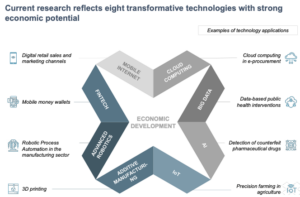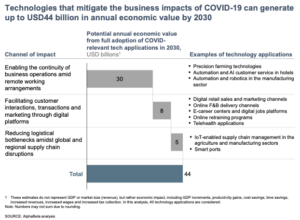

Swee Cheng Wei
Economics Strategy


Asia Pacific’s digital economy has grown significantly in recent years and is well-positioned for further growth thanks to factors including government support and increased digital adoption resulting from demands due to the COVID-19 pandemic. Apart from benefits such as productivity gains, countries are fast realising that digital technologies are important for economic recovery as they help to facilitate economic activities in a “new normal” world. However, there are several challenges preventing countries from reaping the full impact of digital transformation. These include the uneven digital adoption across enterprises and sectors, digital skill gaps, and slow technology innovation. To tackle these challenges, develop targeted policies, and allocate resources efficiently, a crucial starting point is to understand how digital technologies can benefit the economy – particularly in its traditional, non-tech sectors. Yet, there is an existing knowledge gap. Despite comprehensive research on the economic impact of the technology sector, there is limited research on the economic benefits of technologies applied in traditional sectors. Neglecting the impact of digital technology on traditional sectors such as agriculture and health risks overlooking its transformative effects beyond the technology sector. Through our work, we aim to bridge this gap in APAC and here are three relevant insights.
Insight 1: Countries stand to gain from a significant digital transformation prize by 2030 and the benefits are across economic sectors
Digital technologies have the power to unlock significant economic value in Asia Pacific. In particular, eight key technologies and their related technology applications hold transformative potential (Exhibit 1). For instance, selling retail goods through digital e-commerce platforms, facilitated by the mobile Internet, unlocks productivity gains of up to 15% due to reduced labour requirements, inventory efficiencies and lower real estate costs.
Exhibit 1


Source: The Growing Digital Economy in the Philippines
Quantifying the economic impact of over 40 technological applications across sectors in Asia Pacific reveals that digital transformation benefits countries across the region, regardless of economic development. It is estimated that digital technologies have the potential to create an annual economic value of US$236 billion in South Korea, US$80 billion in Thailand and US$60 billion in Pakistan by 2030. To put this in perspective, this is equivalent to about 13%, 16% and 19% of the countries’ gross domestic product (GDP) in 2020 respectively. The sectors projected to be the largest beneficiaries of digital transformation differ by country from “consumer, retail and hospitality” in South Korea and Thailand, and “agriculture and food” in Pakistan.
Insight 2: Digital transformation is critical to ensure that countries can focus on recovery
Beyond its immediate economic impacts like job losses, the pandemic is likely to have long-term implications such as severe disruptions to business operations and tourism-related industries. Technologies can help mitigate these economic impacts by allowing businesses to engage customers digitally, resume operations amid remote working arrangements, and address logistical bottlenecks caused by disruptions to global supply chains. For instance, in Malaysia, it is estimated that a substantial 72% of the economic value achievable from adopting emerging digital technologies (US$44 billion out of US$61 billion) could be derived from technological applications that mitigate business risks posed by the pandemic (Exhibit 2).
Furthermore, there is a range of opportunities for using big data analytics in healthcare, social protection and education to address pandemic related challenges. These include supporting vaccine roll-out, targeting vulnerable populations for social welfare and identifying specific skills gaps. In the post-pandemic era, digital technologies will continue to play an instrumental role in boosting the competitiveness and resilience of businesses. For example, technologies (e.g., virtual reality technology) can potentially broaden the reach and appeal of New Zealand to tourists worldwide beyond its natural scenic settings and transform the entire tourism value chain.
Exhibit 2


Source: Positioning Malaysia as a Regional Leader in the Digital Economy
Insight 3: Governments need to focus on key policy enablers and partner other stakeholders to fully capture this prize
There are existing barriers preventing countries from fully unlocking the benefits of digital transformation, and these differ by country. For example, Vietnam faces challenges including regulatory obstacles (e.g., data localization laws) and limited digital connectivity. For Singapore, barriers range from the limited adoption of advanced digital technologies, especially for small businesses, and a shortage of digital skills. It is encouraging that governments in the region have identified the digital economy as a key growth area (e.g., Singapore’s Research, Innovation and Enterprise 2025 Plan, Vietnam National E-commerce Development Program 2014-2020, Malaysia Digital Economy Blueprint and Smart City Blueprint for Hong Kong 2.0) and are making significant progress in some of these areas. However, there is scope to push further on the policy enablers, and many of these initiatives would require the support of other stakeholders such as businesses and training institutions. For example, nurturing the local technology ecosystem (South Korea, Pakistan), upskilling current and future talents (New Zealand, Indonesia) as well as promoting innovation and digital export opportunities (Japan).
The pandemic has amplified the importance of digital transformation in supporting Asia Pacific to “build back better” and boost long-term economic resilience. Thus, it is even more essential for key stakeholders such as governments and businesses to understand the economic impacts of digital transformation across sectors (“size of the prize”), the gaps hindering the full realization and what can be done collaboratively to reap the benefits. For more information and to work with us on this critical area, please contact Swee Cheng Wei.
Subscribe to our news alerts here.

